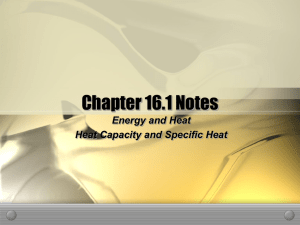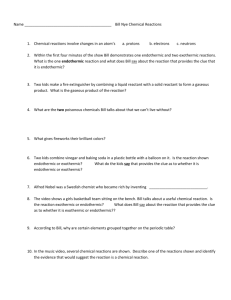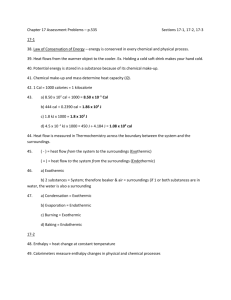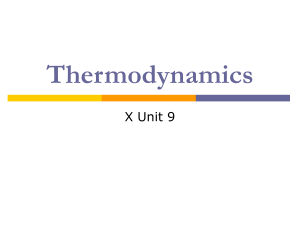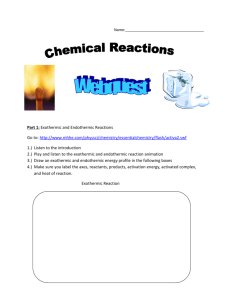Thermochemistry - Fall River Public Schools
advertisement
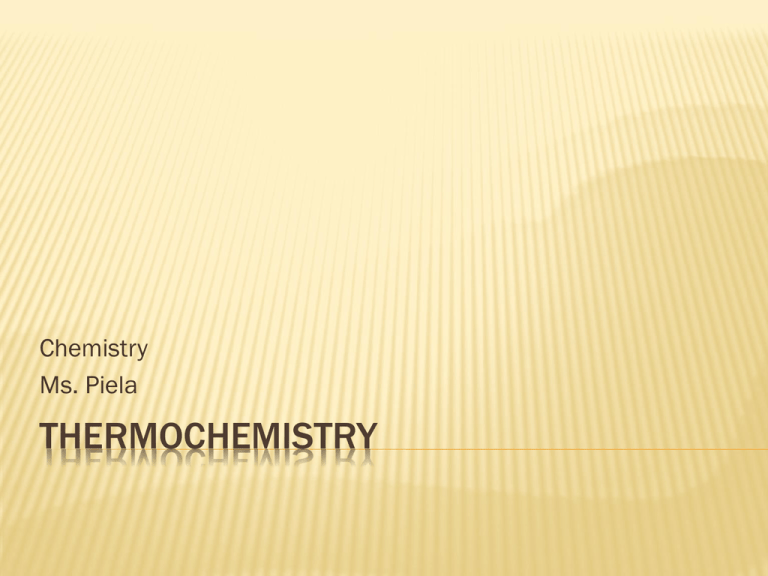
Chemistry Ms. Piela THERMOCHEMISTRY THERMOCHEMISTRY – Heat transfers in chemical reactions Energy Definition: The capacity to do work or supply heat Basic Types: Mechanical, Electrical, Potential, Kinetic CHEMICAL POTENTIAL ENERGY Energy that is stored within chemical bonds Determined by the arrangement and bonding of atoms Examples: Gasoline, Food, etc EXOTHERMIC & ENDOTHERMIC Exothermic Heat processes (‘exits’) flows out of a system EXOTHERMIC AND ENDOTHERMIC System loses heat (negative sign) Examples: Explosions!, Sun, Fire EXOTHERMIC AND ENDOTHERMIC Endothermic Heat processes (‘enter’) is absorbed from surroundings EXOTHERMIC AND ENDOTHERMIC System gains heat (positive sign), Heat change is > 0 Examples: Boiling water, ice melting HEAT – Energy transfers due to temperature differences between objects Flows from hot to cold until temperature equilibrium is reached LAW OF CONSERVATION OF ENERGY – Energy cannot be created or destroyed, only transferred Can be transformed Example: Heat Mechanical Electrical UNITS OF HEAT Calorie (cal) – the amount of heat needed to raise 1 gram of water 1 °C Heat calorie is not to be confused with dietary calories Conversion 1 dietary Factor! Woo! Calorie = 1 kcal = 1000 cal Joule (J) – metric unit of heat and energy CONVERSION PRACTICE It takes 50.2 J to raise the temperature of a 100.0 g piece of glass. How many calories is this? CONVERSATION PRACTICE A small chocolate bar has about 210,000 calories. How many Joules is this? SPECIFIC HEAT – The amount of heat required to raise 1 gram of a substance 1 °C Heat capacity is the amount of heat required to raise a substance 1 °C SPECIFIC HEAT EQUATION q = heat (J or cal) m = mass (g) C = specific heat J g C ∆T = Change in Temp. (°C) SPECIFIC HEAT APPLICATION: LAND VS. WATER Specific heat plays a role in buffering climates Specific heat of land = 0.8 J/g ° C Specific heat of water = 4.184 J/g °C How does this help buffer climates? Water heats up slower and cools down slowly, releasing heat gradually TABLE OF SPECIFIC HEAT CAPACITIES On the notes, you’ll see a table of specific heat capacities for common metals. We’ll be using these throughout all the problems in this section, so keep it handy! SPECIFIC HEAT EXAMPLE 1 A 1.55 g piece of stainless steel absorbs 141 J of heat when its temperature increases by 178 °C. What is the specific heat of stainless steel? .511 J/g °C SPECIFIC HEAT EXAMPLE 2 How much heat is required to raise the temperature of 250.0 g of mercury from 52 °C to 60 °C? 280 J SPECIFIC HEAT EXAMPLE 3 If the initial temperature of a 10.0 g substance is 20.0 °C and 100.0 J of heat are absorbed, what is the final temperature? The specific heat of the substance is 1.15 J/g °C. 28.7 °C
